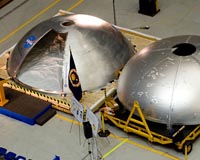 |
Raleigh NC (SPX) Apr 14, 2010 Researchers from North Carolina State University have developed a new way to shape ceramics using a modest electric field, making the process significantly more energy efficient. The process should result in significant cost savings for ceramics manufacturing over traditional manufacturing methods. Ceramics make up significant components of an array of products, including insulators, spark plugs, fuel cells, body armor, gas turbines, nuclear rods, high temperature ball bearings, high temperature structural materials and heat shields. At issue are crystalline defects found in crystalline materials, such as ceramics. "One of these defects is called a grain boundary, which is where crystals with atoms aligned in different directions meet in the material," says Dr. Hans Conrad, emeritus professor of materials science and engineering at NC State and co-author of the study. These boundaries have electrical charges. "We found that if we apply an electric field to a material, it interacts with the charges at the grain boundaries and makes it easier for the crystals to slide against each other along these boundaries. This makes it much easier to deform the material." In other words, the material becomes superplastic - so a ceramic can be shaped into a desirable form using a small amount of force. "We've found that you can bring the level of force needed to deform the ceramic material down to essentially zero, if a modest field is applied," Conrad says. "We're talking between 25 and 200 volts per centimeter, so the electricity from a conventional wall socket would be adequate for some applications." These findings mean that manufacturers who make anything out of ceramics will be able to do so using less energy. "It will make manufacturing processes more cost-effective and decrease related pollution," Conrad says. "And these findings also hold promise for use in the development of new ceramic body armor." Conrad is planning to do additional work using this approach to fabricate ceramic body armor with better properties at a lower cost. The research, "Influence of an applied dc electric field on the plastic deformation kinetics of oxide ceramics," is published in the journal Philosophical Magazine and was funded by the U.S. Army Research Office. The study was co-authored by Conrad and Dr. Di Yang, a senior research associate at NC State. The Department of Materials Science and Engineering is part of NC State's College of Engineering.
Share This Article With Planet Earth
Related Links NC State Space Technology News - Applications and Research
 The Cost Of Manufacturing Space Hardware
The Cost Of Manufacturing Space HardwareHuntsville AL (SPX) Apr 13, 2010 On Tuesday, March 30, NASA and their industry partners unveiled a revolutionary new manufacturing process that could lower the cost of producing a tank dome - the end piece of a fuel tank - as much as 25 percent by using commercial materials and state-of-the-art technologies in an innovative application. Manufacturing a traditional tank dome requires welding eight curved, pie-shaped pieces ... read more |
|
| The content herein, unless otherwise known to be public domain, are Copyright 1995-2010 - SpaceDaily. AFP and UPI Wire Stories are copyright Agence France-Presse and United Press International. ESA Portal Reports are copyright European Space Agency. All NASA sourced material is public domain. Additional copyrights may apply in whole or part to other bona fide parties. Advertising does not imply endorsement,agreement or approval of any opinions, statements or information provided by SpaceDaily on any Web page published or hosted by SpaceDaily. Privacy Statement |